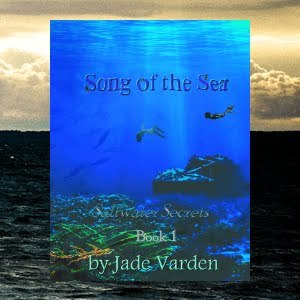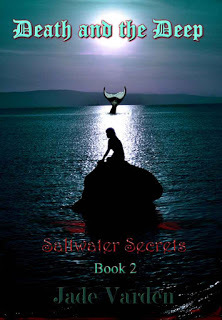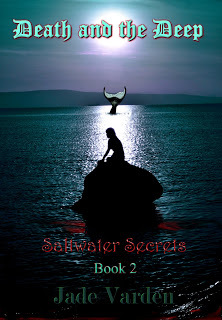Jade Varden's Blog, page 5
October 31, 2015
War and Battle in the Sea
"Jade Varden’s imaginative and creative description of the underwater living world is to be praised, especially for her unique War and Battle in the ocean approach opposing most of the fairytale stories about mermaids and their lands."
 "Song of the Sea" has been expertly photographed and reviewed at Bookidote. Visit the site to read the whole review!
"Song of the Sea" has been expertly photographed and reviewed at Bookidote. Visit the site to read the whole review!
Get your print copy of "Song of the Sea" at Amazon.
 "Song of the Sea" has been expertly photographed and reviewed at Bookidote. Visit the site to read the whole review!
"Song of the Sea" has been expertly photographed and reviewed at Bookidote. Visit the site to read the whole review!Get your print copy of "Song of the Sea" at Amazon.
Published on October 31, 2015 05:30
October 7, 2015
Writing 101: The Non-Character Narrator
First-person narratives directly connect the main character of a book with the audience. I am telling you these things, I am relating my story to you as the first-person narrator. But sometimes, the narrator will talk to you, as a reader, even when they aren't a character in the story itself. It can get a little tricky to pull this off, but it can be an effective tool for certain types of stories.

The Way I Heard It...
In a first-person narrative, the main character is directly relating events that happened (or are happening) to them. But you can also directly address the reader using a narrator who isn't even in the story. These narrators are relaying events that they know about, but didn't experience. And yes, it can be pretty hard to write. But there are reasons why you might want to try it.
Connection: You create an obvious connection with a first-person narrative. You're directly reaching out the audience to tell the reader something firsthand, but secondhand information can be pretty good, too. A narrator who isn't directly in a story is relating it to the reader, and even if they aren't telling a personal story this can still be a strong connection. Everyone knows what it's like to hear a story secondhand. This is how you hear most stories, in fact. It's relatable and real to receive information this way, so you can still connect to your audience with this technique. Objectivity: A narrator who is telling the events but didn't participate in this has a unique perspective. This allows the narrator to be objective in a way that no character who is actually within the story can be. The narrator can perhaps see and understand things that the people in the story don't realize, and that is an incredibly powerful tool for any author. Point of View: First-person narratives are limiting, because you can only show events through one set of eyes. Your main character can't be a part of conversations that take place elsewhere, or see what people are doing in their private time. A narrator who isn't in the story, however, can see a lot more. This narrator can overhear conversations, spy on other characters in their private moments and generally take readers anywhere within the book, in many cases. That's power, and that's useful in any book.
Try telling a story with a non-involved narrator, and you'll get to tell your story from multiple angles that otherwise wouldn't be available to you.

The Way I Heard It...
In a first-person narrative, the main character is directly relating events that happened (or are happening) to them. But you can also directly address the reader using a narrator who isn't even in the story. These narrators are relaying events that they know about, but didn't experience. And yes, it can be pretty hard to write. But there are reasons why you might want to try it.
Connection: You create an obvious connection with a first-person narrative. You're directly reaching out the audience to tell the reader something firsthand, but secondhand information can be pretty good, too. A narrator who isn't directly in a story is relating it to the reader, and even if they aren't telling a personal story this can still be a strong connection. Everyone knows what it's like to hear a story secondhand. This is how you hear most stories, in fact. It's relatable and real to receive information this way, so you can still connect to your audience with this technique. Objectivity: A narrator who is telling the events but didn't participate in this has a unique perspective. This allows the narrator to be objective in a way that no character who is actually within the story can be. The narrator can perhaps see and understand things that the people in the story don't realize, and that is an incredibly powerful tool for any author. Point of View: First-person narratives are limiting, because you can only show events through one set of eyes. Your main character can't be a part of conversations that take place elsewhere, or see what people are doing in their private time. A narrator who isn't in the story, however, can see a lot more. This narrator can overhear conversations, spy on other characters in their private moments and generally take readers anywhere within the book, in many cases. That's power, and that's useful in any book.
Try telling a story with a non-involved narrator, and you'll get to tell your story from multiple angles that otherwise wouldn't be available to you.
Published on October 07, 2015 05:30
October 6, 2015
Writing 101: Author Reviews
It can be really hard to get reviews for a book, and self-published authors are the type of people who take things into their own hands. That’s why some authors go ahead and take the next step on their own, and write author reviews of their own books. Should you...or shouldn’t you?

Your Own Drum
Many self-published authors also review books. I’ve done it before, myself. It’s a good way to get more exposure for indie authors of all kinds, and it’s something to blog about. So what’s to stop an indie author, any kind of author, from reviewing their own book? There are reasons why you shouldn’t, clearly...but there is a way you can do it with a touch of class, too.
Self-promotion is something that every single author has to learn how to do, from me to J.K. Rowling. Some authors get so big that other people will do a lot of promoting for them, too, but it never hurts to bang your own drum, toot your own horn and pat yourself on the back every so often. Writing an author review is a good way to do this, but only if you write that review the right way.
If you’re compelled to write an author review of your work, do it to directly address your reading audience. Instead of a traditional review, word it more like a letter to your readers. Maybe tell them why you wrote the book, what it means to you or how you got the idea. This is a way to directly speak to your readers in a personalized way and give them some juicy tidbits about your book -- without writing something that reeks of self-promotion.
And speaking of needing reviews for your books, there are ways to get them. Look for book bloggers regularly, and send out emails frequently in order to keep those reviews coming.

Your Own Drum
Many self-published authors also review books. I’ve done it before, myself. It’s a good way to get more exposure for indie authors of all kinds, and it’s something to blog about. So what’s to stop an indie author, any kind of author, from reviewing their own book? There are reasons why you shouldn’t, clearly...but there is a way you can do it with a touch of class, too.
Self-promotion is something that every single author has to learn how to do, from me to J.K. Rowling. Some authors get so big that other people will do a lot of promoting for them, too, but it never hurts to bang your own drum, toot your own horn and pat yourself on the back every so often. Writing an author review is a good way to do this, but only if you write that review the right way.
If you’re compelled to write an author review of your work, do it to directly address your reading audience. Instead of a traditional review, word it more like a letter to your readers. Maybe tell them why you wrote the book, what it means to you or how you got the idea. This is a way to directly speak to your readers in a personalized way and give them some juicy tidbits about your book -- without writing something that reeks of self-promotion.
And speaking of needing reviews for your books, there are ways to get them. Look for book bloggers regularly, and send out emails frequently in order to keep those reviews coming.
Published on October 06, 2015 05:30
October 5, 2015
The Art of Being Stubborn
Unless you're one of them, it's hard to know what the life of a really big-time author is like. Imagine having 20 bestsellers on your bookshelf and tons of fans tweeting you all day long. Now imagine that you've got all that...and you still can't really write what you want. One famous author had to keep trying, for 20 years, to create the one project he felt passionate about. His name was Michael Crichton, and his project was a little TV series called "ER." This author knew the art of being stubborn.

He Knew He Could
You know Michael Crichton. He's the guy who wrote "Jurassic Park," "Congo," "The Andromeda Strain" and like several other books that were made into bigtime feature films. But he's also the guy that's ultimately behind "ER," a project that he tried to get going for about 20 years.
It's hard to believe that the author of "Jurassic Park" couldn't get any respect in the TV industry, but that's sort of what happened. Crichton really wanted to create a realistic medical movie or TV series, specifically about hospital emergency rooms, but was basically shut down cold when he started proposing the idea back in the 1970s. TV shows about hospitals didn't get much more real than "General Hospital" in those days, so no one was really interested in the project.
He didn't give up. Crichton continued to hold onto his idea, and honed his idea, and kept on trying to turn it into a reality. Finally, he teamed up with Stephen Spielberg in the 1990s to create "ER," thus making TV history and achieving one of his long-held goals.
Even successful authors run into obstacles and struggle to have their voices heard...yes, even when those voices are enjoyed by millions of readers. Michael Crichton wanted to do something new and different, and on TV instead of on the page. It took him a long time to make it happen, but ultimately he did.
There's a clear moral to this secret story about a famous author: you always have to be stubborn, have to keep trying and have to keep working. And once you do reach all your goals as an author, maybe go ahead and come up with some new ones. You never know what you'll do next.

He Knew He Could
You know Michael Crichton. He's the guy who wrote "Jurassic Park," "Congo," "The Andromeda Strain" and like several other books that were made into bigtime feature films. But he's also the guy that's ultimately behind "ER," a project that he tried to get going for about 20 years.
It's hard to believe that the author of "Jurassic Park" couldn't get any respect in the TV industry, but that's sort of what happened. Crichton really wanted to create a realistic medical movie or TV series, specifically about hospital emergency rooms, but was basically shut down cold when he started proposing the idea back in the 1970s. TV shows about hospitals didn't get much more real than "General Hospital" in those days, so no one was really interested in the project.
He didn't give up. Crichton continued to hold onto his idea, and honed his idea, and kept on trying to turn it into a reality. Finally, he teamed up with Stephen Spielberg in the 1990s to create "ER," thus making TV history and achieving one of his long-held goals.
Even successful authors run into obstacles and struggle to have their voices heard...yes, even when those voices are enjoyed by millions of readers. Michael Crichton wanted to do something new and different, and on TV instead of on the page. It took him a long time to make it happen, but ultimately he did.
There's a clear moral to this secret story about a famous author: you always have to be stubborn, have to keep trying and have to keep working. And once you do reach all your goals as an author, maybe go ahead and come up with some new ones. You never know what you'll do next.
Published on October 05, 2015 05:30
October 3, 2015
Get Jade's New Book
Death and the Deep is finally here!

Amazon Smashwords
Use the links above to get your own copy of Death and the Deep.

Amazon Smashwords
Use the links above to get your own copy of Death and the Deep.
Published on October 03, 2015 05:30
October 1, 2015
Writing 101 Redux: Learning to Research
If you've going to write a book, you're going to have to learn how to research. Read today's Throwback Thursday tip, and learn all my research tricks.

Learning to research is something all authors have to do...but maybe this Writing 101 tip will help you figure it out a little more quickly.

Learning to research is something all authors have to do...but maybe this Writing 101 tip will help you figure it out a little more quickly.
Published on October 01, 2015 05:30
September 30, 2015
Writing 101: Creating Lore
One of the most difficult things for any author to do is create lore, and no I’m not talking about Data’s evil brother (Star Trek shoutout). When you introduce fantasy creatures and certain other elements into your story, there are some questions you’re going to have to answer -- preferably, before you even begin writing the story.

Your Own Private Mythology
Lore is one of those things that’s always evolving. J.K. Rowling included mermaids in her books, Stephenie Meyer found something brand-new to add to vampires and authors everywhere are inventing their own lore right this very moment. If you’re also going to invent your lore, there are some things to keep in mind when you’re doing it.
When you’re creating lore for brand-new characters, you have a great level of freedom. You can come up with anything you want -- like J.R.R. Tolkien and the hobbits. When you’re writing about creatures that have already been established, like vampires, you still have lots of options. Maybe you’ll stick to traditional mythology about vampires, as established by writers like Bram Stoker. Maybe you’ll come up with your own, like a newer author we all know about.
That’s the thing about writing your own lore. You can pretty much write your own ticket, because it’s your book. Some purists may not like new lore you add to established creatures, so that’s something to think about. But no matter what you choose to do about your lore, there’s one thing you’re going to have to do first: establish it.
If you’re creating new lore or re-visiting established lore, you need to know exactly what that lore is before you even begin writing the story. Answer any of your own questions about it, and then some, because your readers will have questions and they will expect to find the answers. You’d better be prepared to give them to those readers. If you don't fully understand your own lore, they’re not going to, either. So make sure you know what it is, and choose to reveal it how you want. Otherwise, you’re going to end up with readers who are confused about what’s going on in your book. And that’s when they’ll choose to put your book down instead.

Your Own Private Mythology
Lore is one of those things that’s always evolving. J.K. Rowling included mermaids in her books, Stephenie Meyer found something brand-new to add to vampires and authors everywhere are inventing their own lore right this very moment. If you’re also going to invent your lore, there are some things to keep in mind when you’re doing it.
When you’re creating lore for brand-new characters, you have a great level of freedom. You can come up with anything you want -- like J.R.R. Tolkien and the hobbits. When you’re writing about creatures that have already been established, like vampires, you still have lots of options. Maybe you’ll stick to traditional mythology about vampires, as established by writers like Bram Stoker. Maybe you’ll come up with your own, like a newer author we all know about.
That’s the thing about writing your own lore. You can pretty much write your own ticket, because it’s your book. Some purists may not like new lore you add to established creatures, so that’s something to think about. But no matter what you choose to do about your lore, there’s one thing you’re going to have to do first: establish it.
If you’re creating new lore or re-visiting established lore, you need to know exactly what that lore is before you even begin writing the story. Answer any of your own questions about it, and then some, because your readers will have questions and they will expect to find the answers. You’d better be prepared to give them to those readers. If you don't fully understand your own lore, they’re not going to, either. So make sure you know what it is, and choose to reveal it how you want. Otherwise, you’re going to end up with readers who are confused about what’s going on in your book. And that’s when they’ll choose to put your book down instead.
Published on September 30, 2015 05:30
September 29, 2015
Writing 101: The Unseen Character
Most characters in your book exist somewhere in the world you’ve created. They interact with other characters, they move things around, they’re in the pages. But you can create another type of character who lives somewhere off the page: the unseen character. Though you don’t lay eyes upon them, they can be very effective in all sorts of different ways.

The Invisible
The unseen character always does things in the background, behind the scenes, and your readers only find out about them third hand. This can be incredibly useful and help you, as a writer, get all sorts of things done. How can you use an unseen character? A few options immediately come to mind.
For comedy. It works very well to use an unseen character just for laughs. Someone who does or says outrageous things, but only offstage, is surprisingly funny and works like a charm. See an example of this storytelling technique in the musical “Gigi.” You never see her mother, but you do hear her singing -- and it’s hilarious.For evil. Allow me to suggest an unseen villain. This is a very creepy way to keep your book scary and intense. A villain you can’t even see is truly terrifying indeed, and I’ll prove it. Just go watch “Jaws.” It’s way scarier when you can’t see the shark. For the plot. Need something to happen? When you need to make a shift or a change in the story in order to get the plot moving along, unseen characters are very useful. Just have them effect the change and you’re done. You didn’t bother to bring them into the story, not really, so you don’t have to think about them again.
Find your own uses for an unseen character, and have a little fun with someone that doesn’t have to be three-dimensional or have all their goals outlined. Inject them into the story for a specific reason and then toss them aside. This is why they exist, so use them for all your storytelling purposes.

The Invisible
The unseen character always does things in the background, behind the scenes, and your readers only find out about them third hand. This can be incredibly useful and help you, as a writer, get all sorts of things done. How can you use an unseen character? A few options immediately come to mind.
For comedy. It works very well to use an unseen character just for laughs. Someone who does or says outrageous things, but only offstage, is surprisingly funny and works like a charm. See an example of this storytelling technique in the musical “Gigi.” You never see her mother, but you do hear her singing -- and it’s hilarious.For evil. Allow me to suggest an unseen villain. This is a very creepy way to keep your book scary and intense. A villain you can’t even see is truly terrifying indeed, and I’ll prove it. Just go watch “Jaws.” It’s way scarier when you can’t see the shark. For the plot. Need something to happen? When you need to make a shift or a change in the story in order to get the plot moving along, unseen characters are very useful. Just have them effect the change and you’re done. You didn’t bother to bring them into the story, not really, so you don’t have to think about them again.
Find your own uses for an unseen character, and have a little fun with someone that doesn’t have to be three-dimensional or have all their goals outlined. Inject them into the story for a specific reason and then toss them aside. This is why they exist, so use them for all your storytelling purposes.
Published on September 29, 2015 05:30
September 28, 2015
The One Who Failed at Self-Publishing
Even if you haven't read "Walden Pond," you've probably heard of Henry David Thoreau. He's well-known for going out into nature and writing about it, doing firsthand research to create his very famous book. What you may not know is that he self-published a book, and didn't do well with it at all.

Unsuccessful at Self-Publishing
Henry David Thoreau published two full-length books, but no one much cared. Neither book sold well, and that includes "Walden Pond," even though Thoreau gained some notoriety as an essayist. His sales were so bad, in fact, that he had to self-published his third novel himself.
"A Week on the Concord and Merrimack Rivers" was self-published by Thoreau himself. His had 1,000 copies of his novel made, but less than half of them ever sold. Only 300 copies were sold to paying customers. In a word, Thoreau's self-publishing adventure was a failure.
It wasn't until much later, well after he died, that critics and readers started noticing his work. They looked at it again, and found that it was actually quite important stuff. Now, Thoreau's name lives on.
Not bad for a self-published author.

Unsuccessful at Self-Publishing
Henry David Thoreau published two full-length books, but no one much cared. Neither book sold well, and that includes "Walden Pond," even though Thoreau gained some notoriety as an essayist. His sales were so bad, in fact, that he had to self-published his third novel himself.
"A Week on the Concord and Merrimack Rivers" was self-published by Thoreau himself. His had 1,000 copies of his novel made, but less than half of them ever sold. Only 300 copies were sold to paying customers. In a word, Thoreau's self-publishing adventure was a failure.
It wasn't until much later, well after he died, that critics and readers started noticing his work. They looked at it again, and found that it was actually quite important stuff. Now, Thoreau's name lives on.
Not bad for a self-published author.
Published on September 28, 2015 05:30
September 26, 2015
Get Death and the Deep September 30
Saltwater Secrets, Book 2: Death and the Deep will be available for purchase September 30! You’ll find it at Amazon, Barnes & Noble, Smashwords and Kobo.

Death and the Deep
I came back to the land because I thought it would be safe. I didn’t know the waves would keep calling me, even weeks after I decided to leave them for ever.
That’s the problem with the ocean. The things we leave behind in the waves have a way of washing back up to the shore. Everything I left in the water is still out there…and I can hear it calling for me, no matter how hard I try to block the sound of the waves.
There is death waiting for me in the deep. Even when I try my best to stay on the land, the ocean won’t stop trying to claim me as one of its own. I’m afraid that soon, it’s going to succeed.
Get a free sample of Death and the Deep right now!

Death and the Deep
I came back to the land because I thought it would be safe. I didn’t know the waves would keep calling me, even weeks after I decided to leave them for ever.
That’s the problem with the ocean. The things we leave behind in the waves have a way of washing back up to the shore. Everything I left in the water is still out there…and I can hear it calling for me, no matter how hard I try to block the sound of the waves.
There is death waiting for me in the deep. Even when I try my best to stay on the land, the ocean won’t stop trying to claim me as one of its own. I’m afraid that soon, it’s going to succeed.
Get a free sample of Death and the Deep right now!
Published on September 26, 2015 05:30



